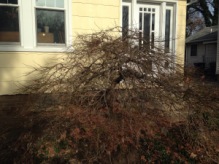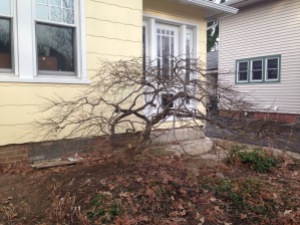
Removing Grass from Groundcovers
- So frustrating! Had a beautiful hill of vinca with tulips and crocus until the grass crept in. I kept thinking I would get to it, but after 3 years of procrastination, I decided to make this small 4×4 patch my priority this year.

- Because I am now serious and focused, I concentrate on my only two choices.
- OPTION 1: Use an herbicide labeled for grasses in ground covers. These can be effective, if applied at the right time and before the grass has become too invasive. My situation is past that.
- OPTION 2: Dig up clumps of grass and remove bare root vinca plants. As daunting as it sounds, I have to dive in to this option.
- Here is one grass-infested clump.

And this is one of several vinca plants with grass and grass roots removed 
After picture: Bare rooted plants are tucked in to grass-free soil just in time for the forecasted 3:00 rain to hit, perfect!

This process, on a 4×4 section took about 2 hours. I made a point to enjoy it. I took the rest of my life, the dogs, the emails, the dust bunnies, and put them on the front porch until I was done with this task. I knew they would still be there when I was satisfied. And I’m not delusional enough not to realize that there are still tiny tenacious grass roots in there, waiting for the chance to overtake again. However, this is my pet focus this year, to keep after intruders in this small space. It will be a game for me, and one I will win, because I love my yard.
Love your yard, it loves you back 10 times.
It’s Pruning Time!
Is everybody cozy?
To some, spending hours outside in below freezing temps may sound unappealing, but this is when I get excited! Every tree I see, I can’t help but imagine which limbs I would remove, how that will cause the tree to respond, and what I can get the tree to do for the greater good. That said, I apologize to people behind me at stoplights.
Here are some good reasons to prune now:
When plants are dormant, they don’t feel the stress of it like they do when they are pumping juices and making food. Also, you are not removing food producing leaves with every cut.
Pruning now prevents infestations of many insects and diseases that take advantage of open wounds during the growing season.
Seeing branch structure is easier with no leaves on the trees, and it’s easier to clean up. And because you’re all covered up, even sticky evergreens are fun to play with.
Here are some objectives to be achieved that you may not have thought of:
For a tight hedge that has become leggy, this is the best time to carefully prune to encourage fast regrowth of inside, and fluffy lower foliage.
Correction of unfortunate pruning mistakes made by well-meaning folks which cause the plant to misbehave, resulting in more maintenance and a plant that doesn’t live up to it’s full aesthetic potential, (in other words, is ugly)

Now, here is a 25 plus year old Japanese maple allowed to grow with little pruning, The owners loved the tree, but were afraid of making a wrong move. Her attachment to the tree (they had planted as a tiny investment when they bought the house) spurred her to call me.

Once the dead branches and limbs that were growing mischievously were removed, the majestic structure that is a Japanese maple, was allowed to fulfill its destiny.
Disclaimer alert! There are some trees and occasions that prefer summer pruning. Please be advised.
What Everyone Should Know About Planting A Tree
 There was a client who hired a reputable landscape company to plant a live screen between himself and his neighbors. Spruce were chosen for the spot and they looked great. But they died, one by one. The company came out and replaced them with more spruce, with the same result. Fortunately, the client asked around, then contacted a friend of mine who is known for his reputation of tree knowledge. The trees were planted in a swale, which is a low place in the property that collects water. Dave told the client he needed to plant to the swale.
There was a client who hired a reputable landscape company to plant a live screen between himself and his neighbors. Spruce were chosen for the spot and they looked great. But they died, one by one. The company came out and replaced them with more spruce, with the same result. Fortunately, the client asked around, then contacted a friend of mine who is known for his reputation of tree knowledge. The trees were planted in a swale, which is a low place in the property that collects water. Dave told the client he needed to plant to the swale.
“What does that mean?” he asked. Dave said, “Let’s plant something that likes the conditions in a swale.”
More important than size, appearance and growth habit, and what is often overlooked, is preferred growing conditions. Different plants have different needs, and when not met, the results are certain to be a disappointment, to say the least. A spruce will not tolerate wet feet for extended periods, while a bald cypress will love you for many years for putting it there. And while not fatal, siting a tri-color beech where it receives hot afternoon sun can turn its beautiful pink leaves’ margins to a “What’s wrong with my tree?” tan.
A tree planted in the wrong place will not maintain the qualities you selected it for. In other words, you are not getting what you wanted.
Yeah, we’re all in a hurry, we all want to save money, but fast-forward to 5 or 10 years from now. When you are looking at the plant that has not given you the shade you hoped for, or the flowers, fall color or screen you wanted, (fill in the blank here), what price would you put on having gotten it right in the first place?
The easiest way is to start with a professional who is passionate about what you want. Make sure what you choose is planted correctly by someone who is passionate about that. Then, nurture your investment by following the care instructions to make sure your perfect choice gets the love it needs to love you back like nobody’s business!
We can give you all that, plus referrals for others who are as passionate as we are.
So if you choose not to consult, at least consider doing this. Before making a final decision on a plant, go to your favorite search engine and type “Growing conditions for _______”. If you know the botanical name, it can weed out unuseful results. (Pun intended, as usual) Choose a source from a university or arboretum for the best information. If your planting site does not meet all of the criteria, keep looking.
We really do want you to be happy. The more people who are happy, makes the world a better place!
